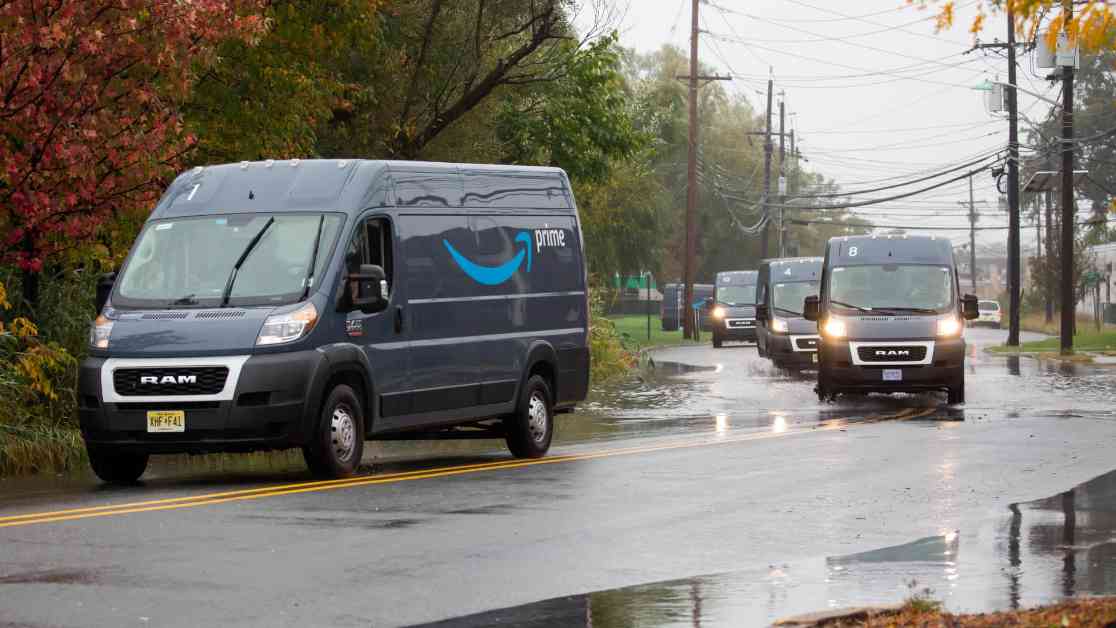Climate Change Impacts Fast Shipping Expectations in the US
Trucks navigate flooded roads while exiting from an Amazon delivery station in Carlstadt, New Jersey, U.S., on Tuesday, Oct. 13, 2020. Bloomberg | Bloomberg | Getty Images
Customers have grown accustomed to the convenience of receiving their online orders in two days or less. However, with the increasing frequency of adverse weather events such as heatwaves in Houston, hurricanes in Florida, and other extreme storms, ensuring fast delivery is becoming a challenge.
Logistics companies have been sounding the alarm about shipping delays caused by extreme weather conditions. According to Freight Waves, weather-related disruptions in the supply chain are projected to cost the industry an estimated $100 billion by 2024. A survey conducted by Breakthrough, a freight solutions company focusing on sustainable transportation, revealed that extreme weather was cited as the top transportation challenge by 500 shippers and carriers.
Jenny Zanden, Chief Operating Officer at Breakthrough, emphasized the impact of climate-related disruptions on transportation strategy, stating, “Shippers and carriers continue to face a myriad of disruptions. Last year, transportation professionals were focused on reducing costs to overcome volatile diesel prices. This year, sustainability and climate-related disruptions are driving the need for fuel efficiency and changes to transportation strategy.”
The challenges posed by extreme weather are not limited to the U.S. but are also affecting key global transportation routes, such as the Panama Canal, where drought conditions have been a concern for shippers. Major retailers in the U.S. are also grappling with the impact of weather-related disruptions on their deliveries and inventory management.
In March, a snowstorm hit Sparks, Nevada, leading to the closure of Donner Pass, a critical route used by many drivers to traverse the northern Sierra mountain range. Walmart, unable to dispatch grocery deliveries from its Sparks center, turned to predictive analytics and artificial intelligence to optimize last-mile strategies. Parvez Musani, Senior Vice President at Walmart, highlighted the importance of technology in addressing disruptions, stating, “We have now this technology at our hand, which allows us to make sure that we continue to serve those customers in the best possible way, run those scenarios, and have those recommendations ready so that we can start taking actions in a much quicker way, rather than waiting for the event to happen and then reacting.”
Walmart leveraged its simulation platform powered by artificial intelligence to create a digital twin of its entire network. This predictive modeling enables the company to anticipate and respond to adverse weather events, identifying stores or warehouses in the weather path that need to be shut down and rerouting orders to alternative locations. During the Sparks storm, Walmart realigned 85 stores across Nevada, California, and Oregon to address the deliveries impacted by the closure of Donner Pass.
Target has also adapted its logistics network to mitigate delays caused by storms and extreme weather conditions, ensuring its supply chain remains agile and responsive. By pre-positioning essential inventory items in areas where storms are predicted to hit, Target aims to maintain its stock levels and meet customer demand efficiently. The retailer utilizes its stores as distribution hubs, allowing it to quickly adjust delivery fulfillment strategies based on changing conditions.
Rising temperatures are posing a significant challenge for retailers like Amazon, impacting warehouse operations and delivery services. Reports of high temperatures in facilities where workers handle heavy boxes have raised concerns about working conditions. To address these challenges, Amazon has implemented algorithms to plan delivery worker routes and optimize efficiency.
In response to extreme heat conditions, Amazon has introduced measures to ensure the well-being of its delivery associates, including providing electrolyte powder, coolers for each vehicle, insulated tumblers, cooling bandanas, and sunscreen. The company has invested in heat mitigation strategies for its warehouses and delivery team, exceeding federal standards to protect workers from extreme temperatures.
Despite the additional costs associated with mitigating adverse weather conditions, companies like Amazon have leveraged predictive analytics and technology to maintain shipping speeds and uphold customer service standards. By utilizing advanced tools and strategies, retailers can optimize their supply chains, minimize disruptions, and enhance the customer experience.
The integration of technology and data-driven solutions has enabled companies to navigate the challenges posed by climate change and extreme weather events. By proactively addressing disruptions and leveraging predictive modeling, businesses can adapt their operations to ensure efficient and reliable delivery services, ultimately fostering customer loyalty and sustainability in the face of evolving environmental risks.

















